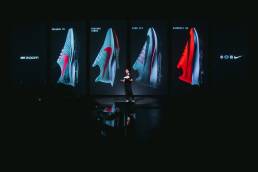How the Swoosh Sprinted
Getting Ahead in the Storytelling Race.
The Starting Line: Nike’s Journey to Narrative Excellence
In the fast-paced world of sportswear and athletic gear, one brand has consistently outpaced the competition: Nike. But Nike’s success isn’t just about selling shoes and apparel. It’s about selling a story – a narrative so compelling that it has transformed Nike from a simple sportswear company into a global cultural icon. This is the power of a well-crafted strategic narrative. Nike’s journey offers invaluable lessons for brands across industries. It’s a testament to the power of storytelling, the importance of customer engagement, and the transformative potential of digital innovation. Let’s lace up and take a run through the key elements of Nike’s strategic narrative.
Understanding Strategic Narratives: More Than Just a Tagline
Before we dive into Nike’s specific approach, it’s crucial to understand what a strategic narrative is and why it matters. A strategic narrative goes beyond a simple mission statement or marketing slogan. It’s a comprehensive story that encapsulates a company’s identity, values, and vision for the future. It’s the thread that weaves together all aspects of a brand’s presence in the market and in consumers’ minds. A powerful strategic narrative:
- Provides a clear sense of purpose and direction for the company
- Engages and inspires both employees and customers
- Guides decision-making at all levels of the organization
- Creates emotional connections that transcend simple transactions
In Nike’s case, their strategic narrative has been the driving force behind their evolution from a niche running shoe company to a global leader in sports and lifestyle branding.
Just Do It: The Power of Emotional Storytelling
At the heart of Nike’s strategic narrative is a masterful approach to emotional storytelling. Nike doesn’t just sell products; it sells dreams, aspirations, and the pursuit of personal excellence. This approach is encapsulated in their iconic slogan, “Just Do It,” which has become more than just a tagline – it’s a call to action that resonates with people around the world. Nike’s storytelling approach is characterized by several key elements:
- Heroic Narratives: Nike positions everyday athletes as heroes in their own journeys. Whether it’s a professional athlete breaking records or an amateur runner completing their first marathon, Nike celebrates the hero’s journey in all its forms.
- Overcoming Adversity: Many of Nike’s campaigns focus on the struggle and perseverance required to achieve greatness. This resonates with consumers who face their own challenges in life and sport.
- Inclusivity: Nike has expanded its narrative to include diverse voices and experiences, ensuring that its story speaks to a broad audience.
- Emotional Resonance: Nike’s ads and campaigns are designed to evoke strong emotions, from inspiration and determination to pride and joy.
One of the most powerful examples of Nike’s storytelling approach was their “Dream Crazy” campaign featuring Colin Kaepernick. The ad, which featured the tagline “Believe in something. Even if it means sacrificing everything,” sparked controversy but also reinforced Nike’s brand as one that stands for something beyond just selling products. This emotional storytelling approach has allowed Nike to create deep, lasting connections with its audience. Consumers don’t just buy Nike products; they buy into the Nike story. They become part of a narrative that extends far beyond the realm of sports and into the broader cultural conversation.
The Customer as the Hero: Nike’s Customer-Centric Approach
While Nike’s narrative often features professional athletes, the true hero in Nike’s story is the everyday consumer. Nike has built its strategic narrative around the idea that everyone who pursues athletic excellence – at any level – is an athlete worthy of celebration. This customer-centric approach is evident in several key initiatives:
- NikePlus Membership: This program offers personalized product recommendations, exclusive access to new releases, and invitations to members-only events. It’s not just a loyalty program; it’s a way for customers to become more deeply engaged with the Nike brand.
- Nike By You (formerly NikeID): This customization platform allows customers to design their own Nike products, giving them a sense of ownership and creativity.
- Nike Run Club and Nike Training Club Apps: These free apps provide guided runs, workouts, and training programs, positioning Nike as a partner in the customer’s fitness journey.
- Nike Adventure Club: A subscription service for kids’ shoes that turns the often frustrating experience of buying children’s footwear into a fun, engaging process for both parents and kids.
By putting the customer at the center of its narrative, Nike has created a brand experience that goes far beyond the point of sale. Customers don’t just buy Nike products; they join the Nike community and become part of the Nike story.
Gamification: Making Brand Engagement Fun
An innovative aspect of Nike’s customer-centric approach has been its use of gamification. By incorporating game-like elements into its apps and experiences, Nike has found a way to make brand engagement not just rewarding, but fun. The Nike Run Club app, for example, allows users to earn achievements, compete with friends, and track their progress over time. This gamified approach turns the often solitary act of running into a social, competitive experience that keeps users coming back for more. Similarly, Nike’s in-store experiences often incorporate interactive elements that blur the line between shopping and play.
The Nike House of Innovation stores, for example, feature areas where customers can test products in simulated sport environments, turning the shopping experience into an adventure. By gamifying engagement, Nike has found a way to keep its brand consistently present in consumers’ lives, even when they’re not actively shopping for products. This ongoing engagement strengthens brand loyalty and keeps Nike top-of-mind for future purchases.
Digital Innovation: Nike’s Technological Sprint
Nike’s strategic narrative isn’t just about emotional storytelling and customer engagement; it’s also about staying at the forefront of digital innovation. Nike has consistently been an early adopter of new technologies, using them to enhance both its products and its marketing efforts. Some key aspects of Nike’s digital innovation include:
- Data-Driven Personalization: Nike uses advanced analytics and machine learning to offer personalized product recommendations and marketing messages. This approach ensures that each customer feels like Nike is speaking directly to them.
- Mobile-First Strategy: Recognizing the shift towards mobile devices, Nike has invested heavily in mobile apps and experiences. The Nike app, for example, offers a seamless shopping experience tailored to each user’s preferences.
- Social Media Mastery: Nike has leveraged social media platforms not just for advertising, but for direct engagement with consumers. Their social media strategy often involves real-time marketing, responding quickly to current events and trends.
- Augmented Reality: Nike has experimented with AR technology to enhance the shopping experience. For example, their SNKRS app uses AR to create scavenger hunt-style experiences for limited edition shoe releases.
- Wearable Technology: Products like the Nike Adapt self-lacing shoes showcase Nike’s commitment to integrating technology directly into their products.
By consistently pushing the boundaries of digital innovation, Nike has positioned itself not just as a sportswear company, but as a technology company. This approach has allowed Nike to stay relevant and exciting in an increasingly digital world.
The Global Playing Field: Nike’s Cultural Impact
Nike’s strategic narrative extends far beyond the realm of sports and into broader cultural conversations. By taking stands on social and political issues, Nike has positioned itself as a brand with values and a voice. Key elements of Nike’s cultural narrative include:
- Social Justice: Campaigns like the Colin Kaepernick ad demonstrate Nike’s willingness to engage with controversial social issues.
- Gender Equality: Nike has been a vocal advocate for women in sports, with campaigns celebrating female athletes and initiatives supporting girls’ participation in sports.
- Sustainability: Nike has made sustainability a key part of its narrative, with initiatives like the “Move to Zero” campaign aimed at reducing waste and carbon emissions.
- Global Perspective: While maintaining its American roots, Nike has successfully adapted its narrative for a global audience, celebrating athletes and sports from around the world.
By engaging with these broader cultural issues, Nike has elevated its brand beyond mere commerce. It has become a cultural force in its own right, capable of shaping conversations and influencing societal norms.
Lessons from Nike’s Narrative Playbook
Nike’s approach to strategic narrative offers valuable lessons for brands across industries:
- Emotion Drives Connection: Nike’s focus on emotional storytelling creates deep, lasting connections with consumers.
- Customer-Centricity is Key: By putting the customer at the heart of its narrative, Nike creates loyal brand advocates.
- Innovation is Non-Negotiable: Nike’s commitment to digital innovation keeps the brand fresh and relevant.
- Stand for Something: Nike’s willingness to take stands on important issues has strengthened its brand identity.
- Think Beyond the Product: Nike’s narrative extends far beyond its products, encompassing lifestyle, culture, and values.
The Finish Line: Nike’s Ongoing Narrative
Nike’s strategic narrative is not a static story, but an evolving one. As the world changes, Nike continues to adapt its narrative, finding new ways to inspire, engage, and innovate. The success of Nike’s approach is evident in its numbers. Despite intense competition and changing consumer behaviors, Nike has maintained its position as the world’s largest supplier of athletic shoes and apparel. In 2022, Nike’s brand value was estimated at $33.2 billion, making it one of the most valuable brands in the world. But perhaps the true measure of Nike’s success is not in its sales figures or brand value, but in the enduring connection it has forged with consumers around the world.
By crafting a strategic narrative that goes beyond products to encompass dreams, values, and cultural relevance, Nike has built something far more enduring than a sportswear empire – it has built a legacy. As we look to the future, one thing is clear: Nike’s story is far from over. With its strong foundation in emotional storytelling, customer engagement, and digital innovation, Nike is well-positioned to continue inspiring and exciting people around the world for generations to come. In the end, Nike’s strategic narrative reminds us that great brands don’t just sell products – they sell stories. And in the case of Nike, it’s a story that continues to resonate, inspire, and push us all to “Just Do It.”
Contact me if you have any questions you’d like answered!
Related Posts
January 16, 2025
Unraveling Allbirds’ Strategic Narrative
Discover how Allbirds' strategic narrative drives success through…
November 18, 2024
Crafting the Future: OpenAI’s Strategic Narrative
Explore OpenAI's strategic narrative and discover how storytelling shapes its…
November 18, 2024
Unpacking Shopify’s Strategic Narrative: Rewriting the Rules of eCommerce
Explore how Shopify transformed from a snowboard shop to a global commerce…
November 12, 2024
Canva’s Strategic Narrative: How Design Democratization Created a $40 Billion Empire
Discover how Canva's strategic narrative empowers creativity through…
Related Posts
January 16, 2025
Unraveling Allbirds’ Strategic Narrative
Discover how Allbirds' strategic narrative drives success through…
November 18, 2024
Crafting the Future: OpenAI’s Strategic Narrative
Explore OpenAI's strategic narrative and discover how storytelling shapes its…
November 18, 2024
Unpacking Shopify’s Strategic Narrative: Rewriting the Rules of eCommerce
Explore how Shopify transformed from a snowboard shop to a global commerce…
November 12, 2024
Canva’s Strategic Narrative: How Design Democratization Created a $40 Billion Empire
Discover how Canva's strategic narrative empowers creativity through…








